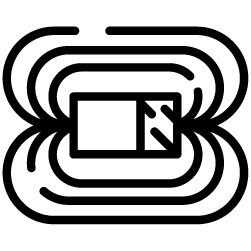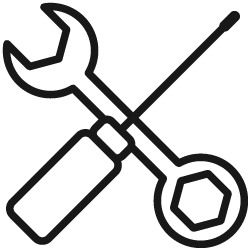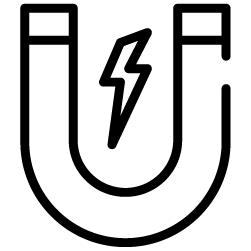Magnets Division
Engineering Services
From concept through production, skilled engineers and technicians carefully guide product development. Engineering staff services include:

Magnetics Design
From concept through production, skilled engineers and technicians carefully guide product development. Engineering staff services include:
• Magnetic strength
• Use of value-added components
• Prototyping
• Shape, size and material selections (combination of magnetic filler and resins)
• Pole configurations and magnetizing methods
• Tooling and tolerances
• Packaging
Our advanced engineering and design department continually searches for improved materials, processes and technologies in order to exceed our customers’ expectations and preserve our industry-leading reputation.
Injection-molded magnets offer tremendous design versatility allowing engineers to add unique features to the magnet or magnet assembly that cannot be easily obtained using ceramic or sintered magnets. Injection-molded magnets are far less brittle, offer tighter tolerances, and meet magnetic requirements to a tighter tolerance. The injection-molding process can hold tolerances down to +/- .0005″ (.01mm). With this in mind you can easily see that tighter air gaps, precision press fits and intricate details can be achieved with great success.
Design features may be assembly keys, mechanical features, reduced part weight and size, inserts, and unique magnet geometry. You may also utilize the option to add a second or even third injection molding process to capture multiple design requirements in one magnetic solution!
Our experience incorporating two or three components in one molded assembly can represent tremendous cost savings. Using fabricated steel inserts is a cost-effective way of eliminating steps in the manufacturing process. Incorporating inserts in bonded-magnet design produces a product that has exceptional uniformity and functionality. Engineered thermoplastics are also an excellent choice as an alternative to steel inserts, offering the opportunity to add structural ribs, fine threads and color coding. Many binder systems can be used when injection molding magnets. Typically a nylon 6 or nylon 12 is used. Other options include PPS, EEA, or heat-resistant polyamides. When optimizing a second or third operation in the molding process, there is a very wide range of thermoplastics available to meet specific requirements.

Value-Added Concepts
From concept through production, skilled engineers and technicians carefully guide product development. Engineering staff services include:
• Magnetic strength
• Use of value-added components
• Prototyping
• Shape, size and material selections (combination of magnetic filler and resins)
• Pole configurations and magnetizing methods
• Tooling and tolerances
• Packaging
Our advanced engineering and design department continually searches for improved materials, processes and technologies in order to exceed our customers’ expectations and preserve our industry-leading reputation.
Injection-molded magnets offer tremendous design versatility allowing engineers to add unique features to the magnet or magnet assembly that cannot be easily obtained using ceramic or sintered magnets. Injection-molded magnets are far less brittle, offer tighter tolerances, and meet magnetic requirements to a tighter tolerance. The injection-molding process can hold tolerances down to +/- .0005″ (.01mm). With this in mind you can easily see that tighter air gaps, precision press fits and intricate details can be achieved with great success.
Design features may be assembly keys, mechanical features, reduced part weight and size, inserts, and unique magnet geometry. You may also utilize the option to add a second or even third injection molding process to capture multiple design requirements in one magnetic solution!
Our experience incorporating two or three components in one molded assembly can represent tremendous cost savings. Using fabricated steel inserts is a cost-effective way of eliminating steps in the manufacturing process. Incorporating inserts in bonded-magnet design produces a product that has exceptional uniformity and functionality. Engineered thermoplastics are also an excellent choice as an alternative to steel inserts, offering the opportunity to add structural ribs, fine threads and color coding. Many binder systems can be used when injection molding magnets. Typically a nylon 6 or nylon 12 is used. Other options include PPS, EEA, or heat-resistant polyamides. When optimizing a second or third operation in the molding process, there is a very wide range of thermoplastics available to meet specific requirements.

Prototyping
• Magnetic strength
• Use of value-added components
• Prototyping
• Shape, size and material selections (combination of magnetic filler and resins)
• Pole configurations and magnetizing methods
• Tooling and tolerances
• Packaging
Our advanced engineering and design department continually searches for improved materials, processes and technologies in order to exceed our customers’ expectations and preserve our industry-leading reputation.
Injection-molded magnets offer tremendous design versatility allowing engineers to add unique features to the magnet or magnet assembly that cannot be easily obtained using ceramic or sintered magnets. Injection-molded magnets are far less brittle, offer tighter tolerances, and meet magnetic requirements to a tighter tolerance. The injection-molding process can hold tolerances down to +/- .0005″ (.01mm). With this in mind you can easily see that tighter air gaps, precision press fits and intricate details can be achieved with great success.
Design features may be assembly keys, mechanical features, reduced part weight and size, inserts, and unique magnet geometry. You may also utilize the option to add a second or even third injection molding process to capture multiple design requirements in one magnetic solution!
Our experience incorporating two or three components in one molded assembly can represent tremendous cost savings. Using fabricated steel inserts is a cost-effective way of eliminating steps in the manufacturing process. Incorporating inserts in bonded-magnet design produces a product that has exceptional uniformity and functionality. Engineered thermoplastics are also an excellent choice as an alternative to steel inserts, offering the opportunity to add structural ribs, fine threads and color coding. Many binder systems can be used when injection molding magnets. Typically a nylon 6 or nylon 12 is used. Other options include PPS, EEA, or heat-resistant polyamides. When optimizing a second or third operation in the molding process, there is a very wide range of thermoplastics available to meet specific requirements.

Custom Tooling and Design

MAGNETIZING FIXTURES AND EQUIPMENT

THERMOPLASTIC DESIGN AND EVALUATION
From concept through production, skilled engineers and technicians carefully guide product development. Engineering staff services include:
• Magnetic strength
• Use of value-added components
• Prototyping
• Shape, size and material selections (combination of magnetic filler and resins)
• Pole configurations and magnetizing methods
• Tooling and tolerances
• Packaging
Our advanced engineering and design department continually searches for improved materials, processes and technologies in order to exceed our customers’ expectations and preserve our industry-leading reputation.
Injection-molded magnets offer tremendous design versatility allowing engineers to add unique features to the magnet or magnet assembly that cannot be easily obtained using ceramic or sintered magnets. Injection-molded magnets are far less brittle, offer tighter tolerances, and meet magnetic requirements to a tighter tolerance. The injection-molding process can hold tolerances down to +/- .0005″ (.01mm). With this in mind you can easily see that tighter air gaps, precision press fits and intricate details can be achieved with great success.
Design features may be assembly keys, mechanical features, reduced part weight and size, inserts, and unique magnet geometry. You may also utilize the option to add a second or even third injection molding process to capture multiple design requirements in one magnetic solution!
Our experience incorporating two or three components in one molded assembly can represent tremendous cost savings. Using fabricated steel inserts is a cost-effective way of eliminating steps in the manufacturing process. Incorporating inserts in bonded-magnet design produces a product that has exceptional uniformity and functionality. Engineered thermoplastics are also an excellent choice as an alternative to steel inserts, offering the opportunity to add structural ribs, fine threads and color coding. Many binder systems can be used when injection molding magnets. Typically a nylon 6 or nylon 12 is used. Other options include PPS, EEA, or heat-resistant polyamides. When optimizing a second or third operation in the molding process, there is a very wide range of thermoplastics available to meet specific requirements.

MAGNETIC MATERIALS AND POLYMER DESIGN AND EVALUATION
- Ferrite Magnets
- Neodymium Iron Boron (MQ)
- Hybrid Magnets

Packaging
From concept through production, skilled engineers and technicians carefully guide product development. Engineering staff services include:
• Magnetic strength
• Use of value-added components
• Prototyping
• Shape, size and material selections (combination of magnetic filler and resins)
• Pole configurations and magnetizing methods
• Tooling and tolerances
• Packaging
Our advanced engineering and design department continually searches for improved materials, processes and technologies in order to exceed our customers’ expectations and preserve our industry-leading reputation.
Injection-molded magnets offer tremendous design versatility allowing engineers to add unique features to the magnet or magnet assembly that cannot be easily obtained using ceramic or sintered magnets. Injection-molded magnets are far less brittle, offer tighter tolerances, and meet magnetic requirements to a tighter tolerance. The injection-molding process can hold tolerances down to +/- .0005″ (.01mm). With this in mind you can easily see that tighter air gaps, precision press fits and intricate details can be achieved with great success.
Design features may be assembly keys, mechanical features, reduced part weight and size, inserts, and unique magnet geometry. You may also utilize the option to add a second or even third injection molding process to capture multiple design requirements in one magnetic solution!
Our experience incorporating two or three components in one molded assembly can represent tremendous cost savings. Using fabricated steel inserts is a cost-effective way of eliminating steps in the manufacturing process. Incorporating inserts in bonded-magnet design produces a product that has exceptional uniformity and functionality. Engineered thermoplastics are also an excellent choice as an alternative to steel inserts, offering the opportunity to add structural ribs, fine threads and color coding. Many binder systems can be used when injection molding magnets. Typically a nylon 6 or nylon 12 is used. Other options include PPS, EEA, or heat-resistant polyamides. When optimizing a second or third operation in the molding process, there is a very wide range of thermoplastics available to meet specific requirements.
We can help you
Our advanced engineering and design department continually searches for improved materials, processes, and technologies to exceed our customers’ expectations and preserve our industry-leading reputation.
Give us a call at (269) 694-9466!